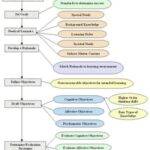FACTORS AFFECTING LEARNING READINESS
Maturation. A child who has not reached a sufficient stage of mental and physical development when he tries to
Perform school tasks characteristic of that stage and that, which entails a higher level of development. However
With proper readiness building procedure, normal development difficulties can be over come.
Experience. Previous experience determines a child’s readiness for learning prior exposure to basic skills is necessary
Before complex tasks are tackled.
Relevance of materials and methods of instruction. Research has shown that children are more ready to learn materials that
Meets their needs and fits their already established interests. Children are more ready to learn skills of spelling, reading and
Writing when they are having fun doing
Emotional attitude and personal adjustment. Emotional stress blocks readiness for learning especially those resulting from
Unmet needs, overprotection, rejection in the home, previous experience of school failure, and other home difficulties.
Building Learning Readiness
This process begins before the child even enters school. The parents should provide books, drawing, reading, and writing materials at
Home. The children should have knowledge about books, pictures, and rudiments of writing. From childhood through school, children should
Be exposed to skills both for their immediate usefulness and for their preparation for new learning. Building learning readiness necessitates
The following steps:
1. Analyze the skills, understanding and knowledge required in studying a given material.
2. Use diagnostic pre-tests and other devices to determine the level each prospective learner possesses the requisite skills, understanding
And knowledge as well as the specific areas of strengths and weaknesses
3. Design the instructional programmed to match the individual needs and abilities of each learner
CLASSICAL CONDITIONING THEORY OF LEARNING
This theory was propounded by a Russian physiologist, Ivan Pavlov (1849 – 1936). He was primarily interested in the circulation of the blood and the
Processes of the gastrointestinal system. He showed little interest in psychology until his later years. For him, the so called “mental events” were no more
Than reflex units of behavior. The study of the nervous systems of animals led him to methods of investigation from which he discovered the techniques of the Condi-
Toning of behavior.
Classical conditioning can be defined as learning resulting from the pairing any artificial stimulus over a number of trials until the artificial stimulus begins to
Produce responses similar to the response, which follows the natural stimulus. Classical conditioning depends on the association of a response an individual makes
Automatically (unconditioned responses) with a previously neutral stimulus (conditioned stimulus). This association is accomplished through pairing the conditioned stimulus
With an unconditioned stimulus that automatically elicits the unconditioned response. After enough pairings, the individual will make the conditioned response when the
When the conditioned stimulus is presented alone. Classical conditioning is also called respondent conditioning because the individual does not respond until after the stimulus
Has been presented ( Gibson, 1980).
Pavlov discovered the technique of conditioning by accident as he was experimenting with dogs to learn about their digestive and salivary functions (Silverman, 1978). He wanted
To determine the connection between the presences of food in a dog’s mouth and the dogs salivary flow. Pavlov inverted the parotid gland of the dog so that its secretions could be accumulated
In a calibrated glass and measured externally. The dog was placed in a harness. Initially the dog salivated at the sight of food. Pavlov discovered that the dog salivated not only at the sight of food
But at also when it heard the sound of a bell before it received food. After some trials, the sound of the bell alone elicited the salivating response. Thus, the dog had learnt that sound of the bell
Would soon lead to it being given something to eat.
Variables in Classical Conditioning Experiment
1. Conditioned stimulus (CS). This is neutral stimulus, which evokes a particular response after conditioning. In Pavlov’s experiment, the CS (bell) originally did not produce salivation.
2. Unconditioned Stimulus (US). The unconditioned stimulus (US) on presentation produces a reflexive unconditioned response (UR). In Pavlov’s experiment, food (US) evokes salivation
(UR) in dogs
3. Unconditioned Response (UR). Before conditioning, the dogs salivate when food (US) is presented.
4. Conditioned Response (CR). Salivation became a conditioned response when it has been associated to a neutral stimulus (CS) that did not originally elicit it. According to Pavlov, if the conditioned
Stimulus and unconditioned stimulus (CS + US) were presented repeatedly, the connection between the conditioned stimulus and conditioned response is strengthened. The more the CS – US pairings,
The stronger.
Pavlov and Learning Process
Pavlov believes that humans learn as a result of conditioning. Learning is an association of paired stimuli and response. Association is therefore very vital to learning. Learning has taken place when a person
Is conditioned to associate a conditioned response to a conditioned stimulus. Learning occurs when the unconditioned stimulus and conditioned stimulus occur together in time, and a response is made
Concepts in Pavlov’s Theory
Extinction. The process by which an established conditioned response is weakened. Extinction occurs when the CS is presented frequently without being paired with the US.
Spontaneous Recovery. The reappearance of a previously extinguished response after a period of time during which the conditioned stimuli has been absent. Usually, however, responses that returns through
Spontaneous recovery is weaker than they were initially and can be extinguished more readily.
Stimulus generalization. This takes place when a conditioned response follows a stimulus that is similar to the original conditioned stimulus. The greater the similarity between two stimuli, the greater likelihood
Of stimulus generalization. Once a US is learned, a CS that is similar to the original CS will also elicit the CR. For example, Pavlov found that a dog that was conditioned to salivate at the tone of tuning fork would
Also response to ringing of a bell, buzzing bees, etc
Stimulus Discrimination. This is the process by which an organism learns to differentiate among stimuli, and restricts its response to one particular stimulus. The ability to make discrimination is the essential factor in human
Learning.
Pavlov and the Teacher
Learning tasks should be presented in a form that is interesting or pleasant to the learner and meet his interests.
The teacher should try to start from known to unknown, that is, establish an association between what the learner already knows and the new topic to be taught for meaningful learning to take place.
The feelings anxiety associated with failure in school may create an aversion to problem solving situations outside of school. The principles of classical conditioning can be used to develop favorable and unfavorable attitudes towards
Learning.


